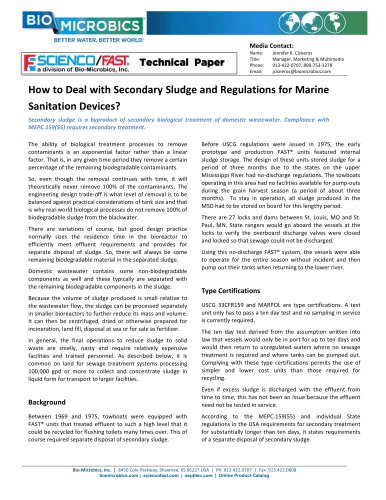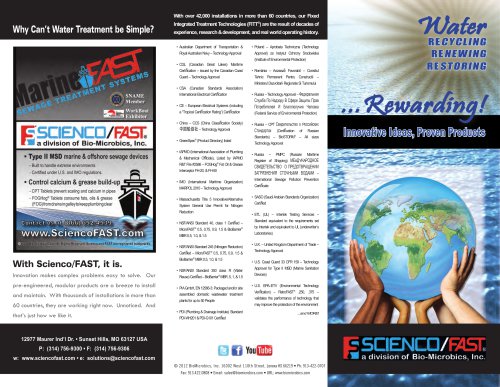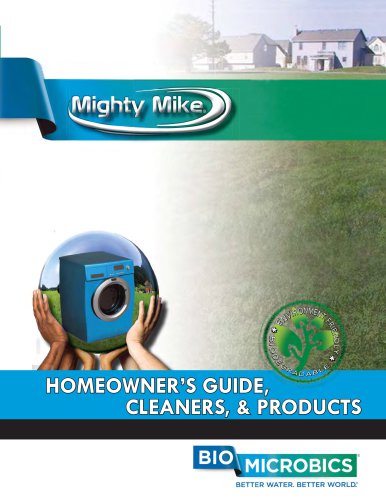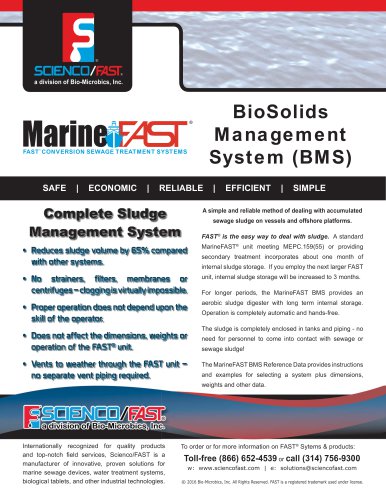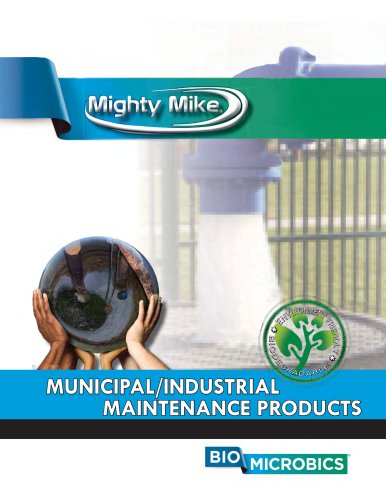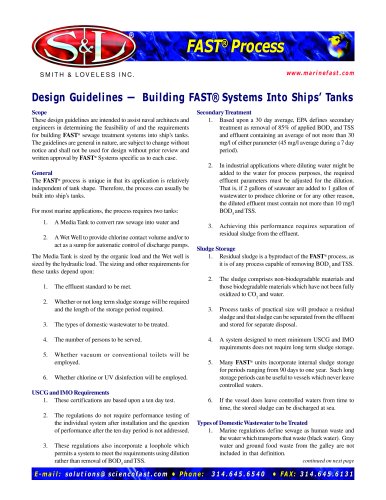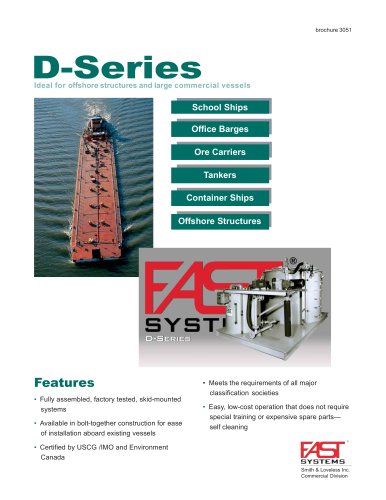
Catalog excerpts
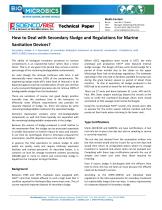
Name: Title: Phone: Email: Jennifer K. Cisneros Manager, Marketing & Multimedia 913‐422‐0707, 800‐753‐3278 jcisneros@biomicrobics.com How to Deal with Secondary Sludge and Regulations for Marine Sanitation Devices? Secondary sludge is a byproduct of secondary biological treatment of domestic wastewater. Compliance with MEPC.159(55) requires secondary treatment. The ability of biological treatment processes to remove contaminants is an exponential factor rather than a linear factor. That is, in any given time period they remove a certain percentage of the remaining biodegradable contaminants. So, even though the removal continues with time, it will theoretically never remove 100% of the contaminants. The engineering design trade‐off is what level of removal is to be balanced against practical considerations of tank size and that is why real‐world biological processes do not remove 100% of biodegradable sludge from the blackwater. There are variations of course, but good design practice normally sizes the residence time in the bioreactor to efficiently meet effluent requirements and provides for separate disposal of sludge. So, there will always be some remaining biodegradable material in the separated sludge. Domestic wastewater contains some non‐biodegradable components as well and these typically are separated with the remaining biodegradable components in the sludge. Because the volume of sludge produced is small relative to the wastewater flow, the sludge can be processed separately in smaller bioreactors to further reduce its mass and volume. It can then be centrifuged, dried or otherwise prepared for incineration, land fill, disposal at sea or for sale as fertilizer. Before USCG regulations were issued in 1975, the early prototype and production FAST® units featured internal sludge storage. The design of these units stored sludge for a period of three months due to the states on the upper Mississippi River had no‐discharge regulations. The towboats operating in this area had no facilities available for pump‐outs during the grain harvest season (a period of about three months). To stay in operation, all sludge produced in the MSD had to be stored on board for this lengthy period. There are 27 locks and dams between St. Louis, MO and St. Paul, MN. State rangers would go aboard the vessels at the locks to verify the overboard discharge valves were closed and locked so that sewage could not be discharged. Using this no‐discharge FAST® system, the vessels were able to operate for the entire season without incident and then pump out their tanks when returning to the lower river. Type Certifications USCG 33CFR159 and MARPOL are type certifications. A test unit only has to pass a ten day test and no sampling in service is currently required. In general, the final operations to reduce sludge to solid waste are smelly, nasty and require relatively expensive facilities and trained personnel. As described below, it is common on land for sewage treatment systems processing 100,000 gpd or more to collect and concentrate sludge in liquid form for transport to larger facilities. The ten day test derived from the assumption written into law that vessels would only be in port for up to ten days and would then return to unregulated waters where no sewage treatment is required and where tanks can be pumped out. Complying with these type certifications permits the use of simpler and lower cost units than those required for recycling. Even if excess sludge is discharged with the effluent from time to time, this has not been an issue because the effluent need not be tested in service. Between 1969 and 1975, towboats were equipped with FAST® units that treated effluent to such a high level that it could be recycled for flushing toilets many times over. This of course required separate disposal of secondary sludge. According to the MEPC.159(55) and individual State regulations in the USA requirements for secondary treatment for substantially longer than ten days, it states requirements of a separate disposal of secondary sludge. Bio‐Microbics, Inc. | 8450 Cole Parkway, Shawnee, KS 66227 USA | Ph: 913.422.0707 | Fax: 913.422.0808 biomicrobics.com | sciencofast.com | septitec.com | Online Product Catalog
Open the catalog to page 1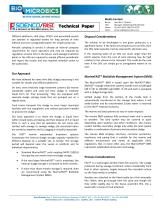
Offshore platforms, drill ships, FPSO’s and associated vessels can operate in regulated waters for long periods of time without access to unregulated waters for simple pump‐out. Periodic sampling in service is already an internal company requirement for some operators and may be required by regulation at some time in the future. Land sewage treatment plants in the USA are required to sample effluent periodically and report the results and any required remedial action to the authorities. Our Approach ...
Open the catalog to page 2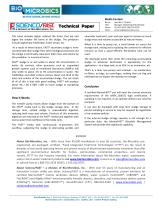
This biota includes higher ordered life forms that eat and digest the simpler life forms in the sludge. The predators include segmented Tubificidae, insect larvae, etc. As a result of these factors, FAST® secondary sludge is more concentrated than sludge from other biological processes and the sludge is continually reduced in both mass and volume by this predation. In numerical terms: FAST® sludge is or will settle to about 4% concentration in water. By contrast, other processes such as suspended growth systems such as membrane bioreactors ...
Open the catalog to page 3All Scienco/FAST catalogs and brochures
-
Water Treatment Solutions
6 Pages
-
DV-Series Reference
2 Pages
-
DESIGN GUIDELINES
4 Pages
-
MarineFAST® Brochure
6 Pages
-
FAST Conversions
4 Pages
-
D-Series sewage treatment
8 Pages
-
LX-Series sewage treatment
4 Pages

